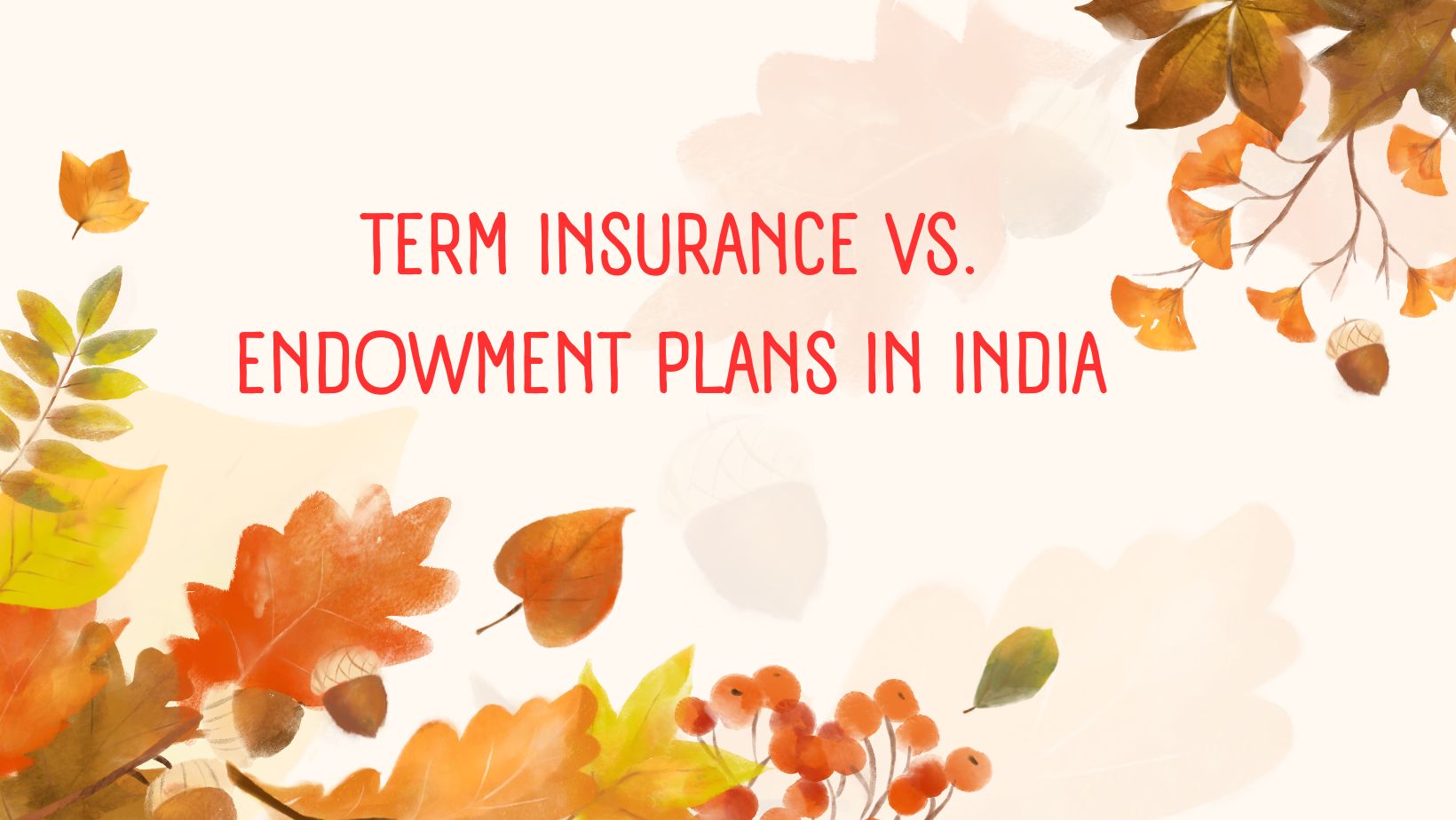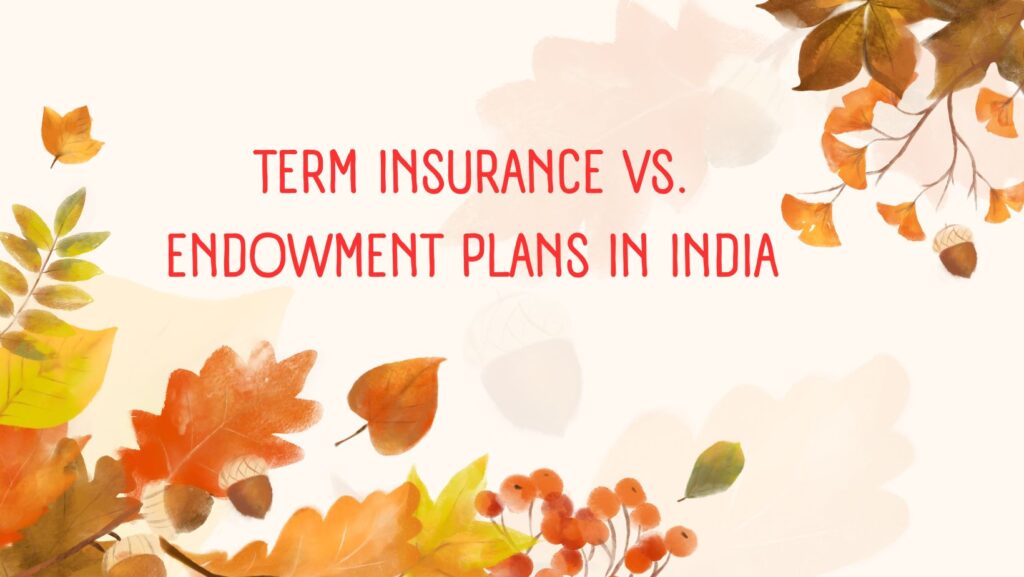Introduction
Insurance is an essential component of financial planning, offering individuals and families the security and protection they need against various uncertainties in life. In India, the insurance sector has witnessed substantial growth in recent years, with a wide range of insurance products available to cater to diverse needs and preferences. Two prominent types of insurance policies that often confuse individuals are Term Insurance and Endowment Plans. In this comprehensive analysis, we will delve deep into the intricacies of these two insurance options to help you make an informed decision.
Section 1: Understanding Term Insurance
Definition and Purpose:
Term insurance is a straightforward and pure form of life insurance. It provides a financial benefit to the policyholder’s beneficiaries if the policyholder passes away during the policy term. Unlike other types of insurance policies, term insurance does not have a savings or investment component; it purely offers protection. Here’s how term insurance works:
Policy Term: The policyholder selects a specific term for coverage, usually ranging from 5 to 30 years. If the policyholder dies during this term, the death benefit is paid out to the beneficiaries.
Premium: The policyholder pays regular premiums to keep the policy in force.
Key Features of Term Insurance:
Affordability: Term insurance is known for its affordability. Since it doesn’t accumulate cash value or offer investment returns, premiums are lower, making it accessible to a wide range of individuals.
Pure Protection: Term insurance offers pure protection, meaning the sole purpose is to provide financial support to the policyholder’s family in case of their untimely demise.
Flexible Policy Term: Policyholders can choose a term that aligns with their financial goals and responsibilities, such as ensuring coverage until children are financially independent or a mortgage is paid off.
High Coverage Amount: Term policies allow for a higher sum assured (coverage amount) at a lower premium compared to endowment plans or whole life insurance.
Tax Benefits: Premiums paid and the death benefit received under term insurance are eligible for tax benefits under Section 80C and Section 10(10D) of the Income Tax Act, respectively.
Section 2: Exploring Endowment Plans
Definition and Purpose:
Endowment plans, on the other hand, are a type of life insurance policy that combines insurance with savings or investment. These plans offer a dual benefit of a life cover and the opportunity to accumulate savings over time. Here’s how endowment plans work:
Premium: Policyholders pay regular premiums, a portion of which goes towards providing insurance coverage, and the rest is invested by the insurance company in various instruments such as bonds, stocks, or other fixed-income securities.
Maturity Benefit: Endowment plans come with a maturity date, typically ranging from 10 to 30 years. If the policyholder survives the term, they receive the maturity benefit, which includes the sum assured along with bonuses and returns from the investments.
Death Benefit: In case of the policyholder’s demise during the policy term, the beneficiaries receive the sum assured, bonuses, and any accumulated savings.
Key Features of Endowment Plans:
Dual Benefit: Endowment plans offer both insurance coverage and a savings component. This appeals to individuals who want to protect their family financially and save for specific life goals simultaneously.
Guaranteed Returns: Most endowment plans provide guaranteed returns, making them a safer investment option compared to other market-linked products.
Maturity Benefit: Policyholders receive a lump-sum amount at the end of the policy term, which can be used for various purposes like children’s education, buying a home, or retirement planning.
Bonuses: Depending on the performance of the insurer’s investments, policyholders may receive annual bonuses or terminal bonuses, enhancing the overall returns.
Tax Benefits: Similar to term insurance, premiums paid towards endowment plans are eligible for tax deductions under Section 80C, and the maturity benefit is tax-free under Section 10(10D) of the Income Tax Act.
Section 3: A Comparative Analysis
Now that we have a clear understanding of term insurance and endowment plans, let’s compare these two insurance options across various parameters to help you make an informed decision:
- Purpose of Insurance:
Term Insurance: Purely designed for financial protection, ensuring your family’s financial security in case of your demise during the policy term.
Endowment Plans: Offers a combination of insurance coverage and savings, helping you achieve specific financial goals.
- Premiums:
Term Insurance: Generally, term insurance premiums are lower compared to endowment plans because they only cover the risk of death.
Endowment Plans: Premiums are higher as they include both the cost of insurance and the investment component.
- Coverage Amount:
Term Insurance: Allows for a higher coverage amount (sum assured) for a given premium, maximizing protection.
Endowment Plans: Coverage amount may be lower compared to term insurance, as a portion of the premium goes towards savings and investments.
- Investment Component:
Term Insurance: Does not have an investment component; hence, there are no returns or bonuses.
Endowment Plans: Accumulates savings over the policy term, offering guaranteed returns, annual bonuses, and possibly terminal bonuses.
- Liquidity:
Term Insurance: Offers no liquidity during the policy term; it only pays out in the event of the policyholder’s death.
Endowment Plans: Provides liquidity through the maturity benefit, which can be used for various financial goals.
- Flexibility:
Term Insurance: Offers flexibility in choosing the policy term and coverage amount based on individual needs.
Endowment Plans: Generally, less flexible due to the predetermined policy term and limited options.
- Returns:
Term Insurance: Offers no returns on the premium paid; it is purely an expense for protection.
Endowment Plans: Provides guaranteed returns, making it a safer option for risk-averse individuals.
- Tax Benefits:
Term Insurance: Premiums paid and death benefit received are eligible for tax benefits.
Endowment Plans: Enjoy similar tax benefits on premiums and maturity benefit.
- Suitability:
Term Insurance: Ideal for individuals seeking pure protection and those with tight budgets.
Endowment Plans: Suitable for those who want a combination of insurance and savings, and are willing to pay higher premiums for guaranteed returns.
Section 4: When to Choose Term Insurance?
Term insurance is the right choice under the following circumstances:
Financial Protection Priority: If your primary concern is to secure your family’s financial future in case of your untimely demise, term insurance is the best option.
Limited Budget: If you have a tight budget and can’t afford higher premium payments, term insurance allows you to get substantial coverage without straining your finances.
Temporary Financial Responsibilities: If you have specific financial responsibilities with a defined duration, such as paying off a mortgage or ensuring your children’s education, term insurance aligns with these goals.
Investment Preferences: If you prefer separate investment avenues and want to keep insurance and investments distinct, term insurance is the choice for you. You can invest in other instruments like mutual funds or fixed deposits.
Section 5: When to Choose Endowment Plans?
Endowment plans are a suitable choice under the following circumstances:
Savings and Protection: If you want both insurance coverage and a savings component bundled into one policy, endowment plans offer the dual benefit you seek.
Guaranteed Returns: If you are risk-averse and prefer investments with guaranteed returns, endowment plans provide a safer option compared to market-linked products.
Long-Term Goals: If you have long-term financial goals, such as buying a house or planning for retirement, endowment plans help you accumulate savings over time to meet these objectives.
Disciplined Savings: If you lack discipline in saving and investing separately, endowment plans enforce a regular premium payment that builds savings over the policy term.
Section 6: Conclusion
In conclusion, the choice between term insurance and endowment plans in India depends on your individual financial goals, preferences, and budget. Term insurance offers straightforward and affordable protection, making it an ideal choice for those prioritizing financial security for their loved ones. On the other hand, endowment plans cater to individuals seeking a combination of insurance coverage and guaranteed returns, making it suitable for long-term financial planning.
It’s essential to assess your financial needs, risk tolerance, and investment preferences before making a decision. Some individuals may even opt for a combination of both term insurance and endowment plans to strike a balance between pure protection and savings. Ultimately, the key is to align your insurance choice with your broader financial objectives and secure your financial future accordingly.
Both term insurance and endowment plans have their merits, and the right choice depends on your unique circumstances. Therefore, it’s advisable to consult with a financial advisor who can provide personalized guidance based on your financial goals and risk profile. Making an informed decision regarding your insurance needs is crucial for achieving financial peace of mind in the long run.

